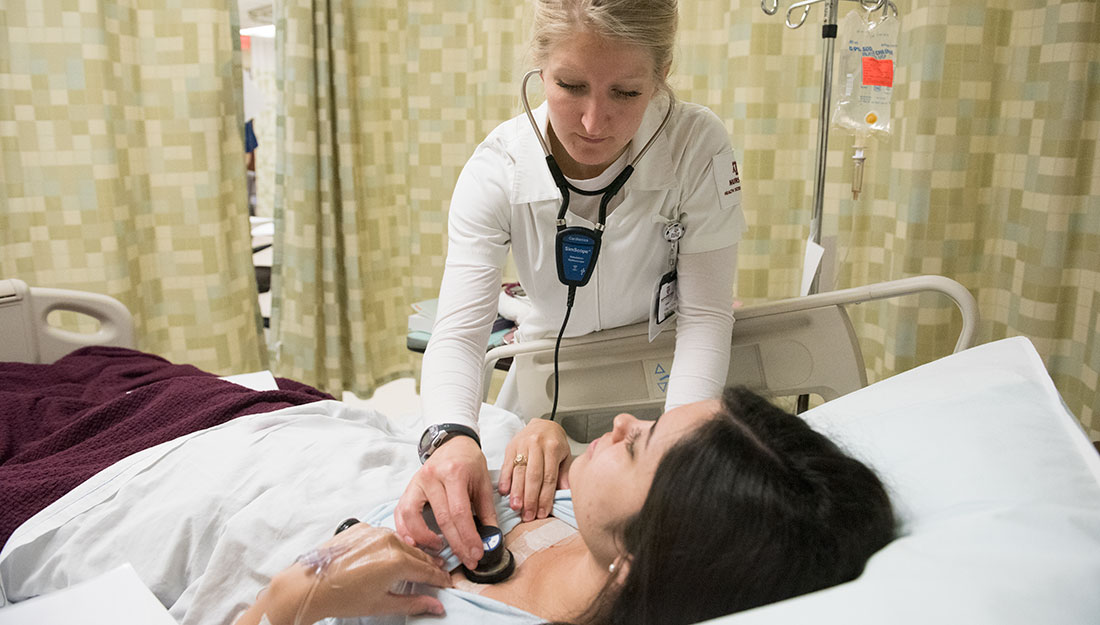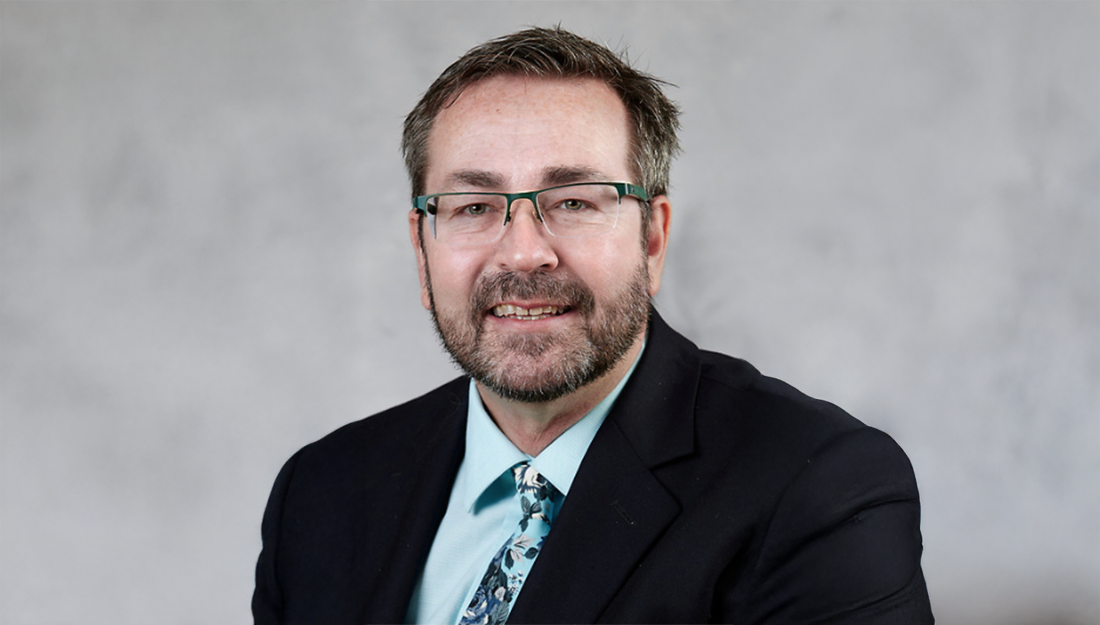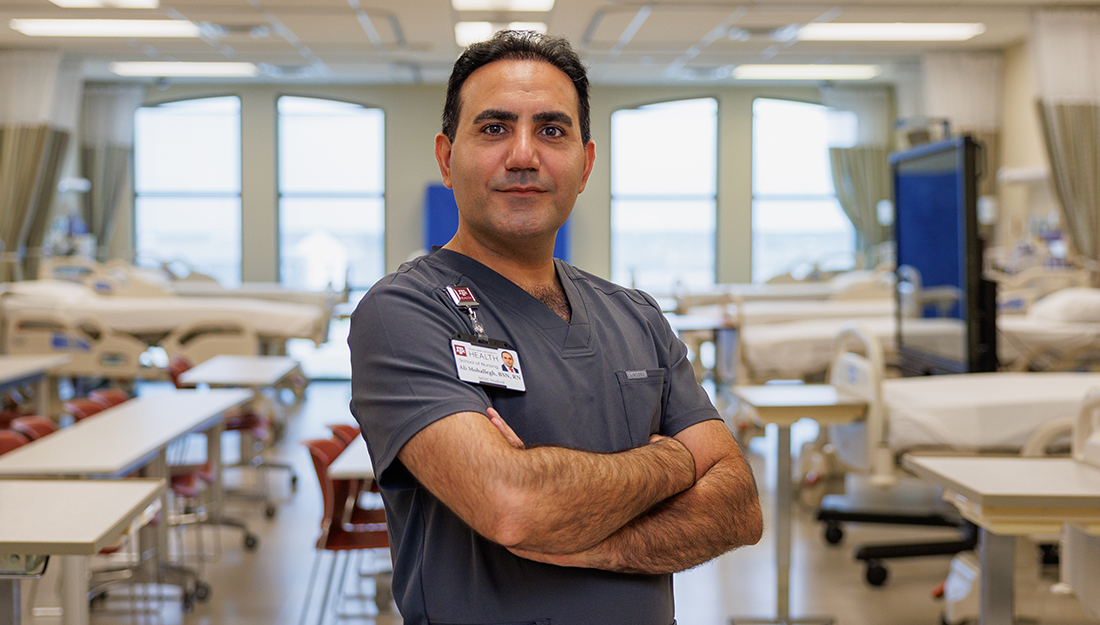- Christina Sumners
- Editor's Pick, Nursing, Show on VR homepage
Borrowing from Hollywood to teach future nurses
Technological advances create level of realism in simulation previously unimaginable

Small patches applied to the SP’s skin send a signal to these special stethoscopes to mimic whatever sound the situation calls for.
Mia Ramirez is a 16-year-old on her way to softball practice when she hits a tree and is ejected from her vehicle. She comes into the emergency department covered in blood, mud and glass, still dressed in her softball uniform. Her frightened parents won’t leave their daughter’s side to allow the medical team to work.
It looks like something out of a television medical drama, but these are future health care professionals, not actors, the “parents” are standardized patients (SPs) and Mia is a life-like manikin.
“She was so realistic,” said Jacqueline Stout-Aguilar, Ph.D., registered nurse and a clinical assistant professor at the Texas A&M Health Science Center College of Nursing. “The staff has one common goal: To give the students top-of-the line experience and exposure to real-life situations.”
This is just one of numerous scenarios put on at the Health Science Center’s Clinical Learning Resource Center (CLRC), a realistic hospital-type training facility, from complications during delivery to an infant with a high fever, that give nurses the chance to work alongside future physicians and pharmacists in what’s called interprofessional education.
And just like viewers do when watching a television show, these students practice “suspension of disbelief.”
“We have a lot of different ways we can make things come to life,” said Megan Doyel, BSN, assistant director of the CLRC. “That’s our job: To make the simulation so believable that the students can suspend their disbelief and really think that they are in a live encounter with a real patient.”
Although nursing students have always used simulation in their learning process, faculty are utilizing the Health Science Center’s simulation capabilities more and more. They already use the same Pyxis MedStation™ (a medication dispensing system) hospitals do, and they use manikins to practice skills like inserting a catheter or putting in an IV line. And with a new Nursing Innovation Grant to help build lab and simulation capacity from the Texas Higher Education Coordinating Board, there are even more opportunities. With these funds, the College of Nursing has purchased GoPro cameras, SimScopes, two SmartBoards and even a 3D printer.
The 3D printer is used to create plastic models of whatever the instructor is teaching, from hip fractures to an abnormal heart. “The 3D-printed models allow the students to directly observe abnormalities in body parts related to a specific disease process that can then be paired with a simulation experience based on the disease,” said Brian Holland, Ph.D., R.N., assistant dean for undergraduate studies at the Texas A&M College of Nursing. “This provides an experiential learning experience that links theory to practice.”
The interactive SmartBoards—which are used for care planning, concept maps, physician order interpretation and debriefing after the simulation—allow for documents to be projected on the screen, written all over and discussed. “These boards are extremely popular among the students because they make it easy to pull together information and understand what went well and what can be improved upon,” Holland said.
GoPro cameras are another new way the students can evaluate their own patient care.
In this case, of course, the “patients” aren’t really sick. Instead, they’ve been trained on a particular case, and they understand the history and symptoms they are acting out. “Our standardized patients are trained to become this person,” Doyel said. “To be an SP, you really have to have a heart to help the students and improve their education.”
In this case, the standardized patients were willing to wear GoPro cameras on their heads throughout the simulation to help the students learn. “What that does is allow the student to see their engagement and contact from the patient’s perspective,” Holland said. “Did they make eye contact? What were their nonverbal cues like? It’s a unique perspective.”
One of the main things the students learn in the CLRC is accurate communication and holistic care.
“There’s a real person in the bed who you have to talk to, look at, acknowledge, and you have to explain to that ‘patient’ what you’re doing,” added Angela Mulcahy, M.S., registered nurse and clinical assistant professor at the Texas A&M College of Nursing.
SimScopes also aid in the learning process by adding to the realism. Small patches applied to the SP’s skin send a signal to these special stethoscopes to mimic whatever sound the situation calls for. “With the SimScopes, the SPs will actually have crackling in their lungs,” Stout-Aguilar said. “We can fake that, which is awesome.”
The important thing is that the CLRC, much like a television set, isn’t real. Although the students do their best, Mia can’t be saved.
“We want to foster a safe environment where students know that if they do make a mistake, or if they’re awkward, or they give the wrong medication, it’s not catastrophic,” Stout-Aguilar said. “They learn from this actual human interaction and transition that into practice, so they won’t make that mistake in the real clinical setting.”
The students then have the opportunity to practice telling Mia’s parents about their “daughter’s” death, which is excellent practice for their future careers.
The instructors agree that the CLRC, the manikins and the SP program make the students better health care providers, and the new technology provided by the grant will only improve their training.
“When the graduates go out into practice and they’re representing Texas A&M, they’ve had this experience with standardized patients, and that exposure makes them great providers,” Stout-Aguilar said. “They always say, ‘this really prepared me for the real world, and I wasn’t afraid to go into that room by myself, because I had done that before.’”
“We believe this all translates to a higher level of care and better patient outcomes,” Holland added. “It’s all about our students. We just want them to have a really good learning experience.”
Media contact: media@tamu.edu


